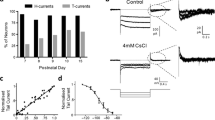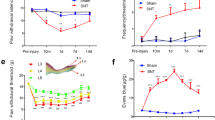Abstract
The sacral dorsal commissural nucleus (SDCN) in the spinal cord receives both somatic and visceral primary afferents. Transient receptor potential vanilloid 1 (TRPV1) channels are preferentially expressed in certain fine primary afferents. However, knowledge of the SDCN neurons postnatal excitability development and their contacts with TRPV1 fibers remains elusive. Here, whole-cell recordings were conducted in spinal cord slices to evaluate the postnatal development of SDCN neurons and their possible contacts with functional TRPV1-expressing terminals. SDCN neurons in neonatal (postnatal day (P) 1–2), young (P8-10), and adult rats (P35-40) have different electrophysiological properties. SDCN neurons in neonatal rats have higher frequency of spontaneous firing, higher resting membrane potential, and lower presynaptic glutamate release probability. However, no difference in quantal release was found. At all developmental stages, TRPV1 activation with the selective agonist capsaicin increases glutamate release in the presence of tetrodotoxin, which blocks action potential-dependent and polysynaptic neurotransmission, indicating that functional TRPV1 fibers innervate SDCN neurons directly. Capsaicin-induced presynaptic glutamate release onto SDCN neurons depends on external Ca2+ influx through TRPV1 channels; voltage-dependent calcium channels had a slighter impact. In contrast, capsaicin blocked C fiber-evoked synaptic transmission, indicating that TRPV1 activation has opposite effects on spontaneous asynchronous and action potential-dependent synchronous glutamate release. These data indicate that excitability of SDCN neurons undergoes a developmental shift, and these neurons receive functional TRPV1 terminals from early postnatal stage. The opposite action of capsaicin on asynchronous and synchronous glutamate release should be taken into account when TRPV1 channels are considered as therapeutic targets.






Similar content being viewed by others
References
Honda CN (1985) Visceral and somatic afferent convergence onto neurons near the central canal in the sacral spinal cord of the rat. J Neurophysiol 53:1059–1078
Feng Y-P, Li Y-Q, Wang W, Wu S-X, Chen T, Shigemoto R, Mizuno N (2005) Morphological evidence for GABA/glycine-cocontaining terminals in synaptic contact with neurokinin-1 receptor-expressing neurons in the sacral dorsal commissural nucleus of the rat. Neurosci Lett 388:144–148
Xu T-L, Nabekura J, Akaike N (1996) Protein kinase C-mediated enhancement of glycine response in rat sacral dorsal commissural neurones by serotonin. J Physiol Lond 496:491–501
Ding Y-Q, Qin B-Z, Li J-S, Mizuno N (1994) Induction of c-fos-like protein in the spinoparabrachial tract-neurons locating within the sacral parasympathetic nucleus in the rat. Brain Res 659:283–286
Lu Y, Inokuchi H, McLachlan EM, Li J-S, Higashi H (2001) Correlation between electrophysiology and morphology of three groups of neuron in the dorsal commissural nucleus of lumbosacral spinal cord of mature rats studied in vitro. J Comp Neurol 437:156–169
Basbaum AI, Bautista DM, Scherrer G, Julius D (2009) Cellular and molecular mechanisms of pain. Cell 139:267–284
Caterina MJ, Schumacher MA, Tominaga M, Rosen TA, Levine JD, Julius D (1997) The capsaicin receptor: a heat-activated ion channel in the pain pathway. Nature 389:816–824
Tominaga M, Caterina MJ, Malmberg AB, Rosen TA, Gilbert H, Skinner K, Raumann BE, Basbaum AI, Julius D (1998) The cloned capsaicin receptor integrates multiple pain-producing stimuli. Neuron 21:531–543
Guo A, Vulchanova L, Wang J, Li X, Elde R (1999) Immunocytochemical localization of the vanilloid receptor 1 (VR1): relationship to neuropeptides, the P2X3 purinoceptor and IB4 binding sites. Eur J Neurosci 11:946–958
Guo A, Simone DA, Stone LS, Fairbanks CA, Wang J, Elde R (2001) Developmental shift of vanilloid receptor 1 (VR1) terminals into deeper regions of the superficial dorsal horn: correlation with a shift from TrkA to Ret expression by dorsal root ganglion neurons. Eur J Neurosci 14:293–304
Hwang SJ, Valtschanoff JG (2003) Vanilloid receptor VR1-positive afferents are distributed differently at different levels of the rat lumbar spinal cord. Neurosci Lett 349:41–44
Hwang SJ, Burette A, Rustioni A, Valtschanoff JG (2004) Vanilloid receptor VR1-positive primary afferents are glutamatergic and contact spinal neurons that co-express neurokinin receptor NK1 and glutamate receptors. J Neurocytol 33:321–329
Yeo EJ, Cho YS, Paik SK, Yoshida A, Park MJ, Ahn DK, Moon C, Kim YS, Bae YC (2010) Ultrastructural analysis of the synaptic connectivity of TRPV1-expressing primary afferent terminals in the rat trigeminal caudal nucleus. J Comp Neurol 518:4134–4146
Peters JH, McDougall SJ, Fawley JA, Smith SM, Andresen MC (2010) Primary afferent activation of thermosensitive TRPV1 triggers asynchronous glutamate release at central neurons. Neuron 65:657–669
Yang K, Kumamoto E, Furue H, Yoshimura M (1998) Capsaicin facilitates excitatory but not inhibitory synaptic transmission in substantia gelatinosa of the rat spinal cord. Neurosci Lett 255:135–138
Kim H, Cui L, Kim J, Kim SJ (2009) Transient receptor potential vanilloid type 1 receptor regulates glutamatergic synaptic inputs to the spinothalamic tract neurons of the spinal cord deep dorsal horn. Neuroscience 160:508–516
Labrakakis C, MacDermott AB (2003) Neurokinin receptor 1-expressing spinal cord neurons in lamina I and III/IV of postnatal rats receive inputs from capsaicin sensitive fibers. Neurosci Lett 352:121–124
Nakatsuka T, Furue H, Yoshimura M, Gu JG (2002) Activation of central terminal vanilloid receptor-1 receptors and αβ-methylene-ATP-sensitive P2X receptors reveals a converged synaptic activity onto the deep dorsal horn neurons of the spinal cord. J Neurosci 22:1228–1237
Baccei ML, Fitzgerald M (2004) Development of GABAergic and glycinergic transmission in the neonatal rat dorsal horn. J Neurosci 24:4749–4757
Fitzgerald M (2005) The development of nociceptive circuits. Nat Rev Neurosci 6:507–520
Hathway GJ, Fitzgerald M (2008) The development of nociceptive systems. In: Basbaum AI, Bushnell MC (eds) Science of pain. Elsevier, Amsterdam, pp 133–145
Wu S-X, Wang W, Li H, Wang Y-Y, Feng Y-P, Li Y-Q (2010) The synaptic connectivity that underlies the noxious transmission and modulation within the superficial dorsal horn of the spinal cord. Prog Neurobiol 91:38–54
Cavanaugh DJ, Chesler AT, Bráz JM, Shah NM, Julius D, Basbaum AI (2011) Restriction of transient receptor potential vanilloid-1 to the peptidergic subset of primary afferent neurons follows its developmental downregulation in nonpeptidergic neurons. J Neurosci 31:10119–10127
Yang K, Li Y-Q, Kumamoto E, Furue H, Yoshimura M (2001) Voltage-clamp recordings of postsynaptic currents in substantia gelatinosa neurons in vitro and its applications to assess synaptic transmission. Brain Res Brain Res Protoc 7:235–240
Yoshimura M, Nishi S (1993) Blind patch-clamp recordings from substantia gelatinosa neurons in adult rat spinal cord slices: pharmacological properties of synaptic currents. Neuroscience 53:519–526
Park JS, Nakatsuka T, Nagata K, Higashi H, Yoshimura M (1999) Reorganization of the primary afferent termination in the rat spinal dorsal horn during post-natal development. Dev Brain Res 113:29–36
Yang K, Kumamoto E, Furue H, Li Y-Q, Yoshimura M (2000) Capsaicin induces a slow inward current which is not mediated by substance P in substantia gelatinosa neurons of the rat spinal cord. Neuropharmacology 39:2185–2194
Yang K, Furue H, Fujita T, Kumamoto E, Yoshimura M (2003) Alterations in primary afferent input to substantia gelatinosa of adult rat spinal cord after neonatal capsaicin treatment. J Neurosci Res 74:928–933
Yang K, Ma H (2011) Blockade of GABAB receptors facilitates evoked neurotransmitter release at spinal dorsal horn synapse. Neuroscience 193:411–420
Tong CK, MacDermott AB (2006) Both Ca2+-permeable and -impermeable AMPA receptors contribute to primary synaptic drive onto rat dorsal horn neurons. J Physiol Lond 575:133–144
Yang K, Kumamoto E, Furue H, Li Y-Q, Yoshimura M (1999) Action of capsaicin on dorsal root-evoked synaptic transmission to substantia gelatinosa neurons in adult rat spinal cord slices. Brain Res 830:268–273
Fatt P, Katz B (1951) An analysis of the end-plate potential recorded with an intracellular electrode. J Physiol Lond 115:320–370
Katz B (1966) Nerve muscle and synapse. McGraw Hill, New York
Binshtok AM, Bean BP, Woolf CJ (2007) Inhibition of nociceptors by TRPV1-mediated entry of impermeant sodium channel blockers. Nature 449:607–610
Coull JA, Boudreau D, Bachand K, Prescott SA, Nault F, Sík A, De Koninck P, De Koninck Y (2003) Trans-synaptic shift in anion gradient in spinal lamina I neurons as a mechanism of neuropathic pain. Nature 424:938–942
Jennings E, Fitzgerald M (1996) C-fos can be induced in the neonatal rat spinal cord by both noxious and innocuous peripheral stimulation. Pain 68:301–306
Baccei ML, Fitzgerald M (2005) Intrinsic firing properties of developing rat superficial dorsal horn neurons. NeuroReport 16:1325–1328
Baccei ML, Bardoni R, Fitzgerald M (2003) Development of nociceptive synaptic inputs to the neonatal rat dorsal horn: glutamate release by capsaicin and menthol. J Physiol Lond 549:231–242
Bardoni R (2001) Excitatory synaptic transmission in neonatal dorsal horn: NMDA and ATP receptors. News Physiol Sci 16:95–100
Ingram RA, Fitzgerald M, Baccei ML (2008) Developmental changes in the fidelity and short-term plasticity of GABAergic synapses in the neonatal rat dorsal horn. J Neurophysiol 99:3144–3150
Li J, Kritzer E, Craig PE, Baccei ML (2015) Aberrant synaptic integration in adult lamina I projection neurons following neonatal tissue damage. J Neurosci 35:2438–2451
Li Y-Q, Li H, Yang K, Kaneko T, Mizuno N (2000) Morphologic features and electrical membrane properties of projection neurons in the marginal layer of the medullary dorsal horn of the rat. J Comp Neurol 424:24–36
Li Y-Q, Li H, Yang K, Wang Z-M, Kaneko T, Mizuno N (2000) Intracellular labeling study of neurons in the superficial part of the magnocellular layer of the medullary dorsal horn of the rat. J Comp Neurol 428:641–655
Lorenzo LE, Ramien M, St Louis M, De Koninck Y, Ribeiro-da-Silva A (2008) Postnatal changes in the Rexed lamination and markers of nociceptive afferents in the superficial dorsal horn of the rat. J Comp Neurol 508:592–604
Szallasi A, Nilsson S, Farkas-Szallasi T, Blumberg PM, Hökfelt T, Lundberg JM (1995) Vanilloid (capsaicin) receptors in the rat: distribution in the brain, regional differences in the spinal cord, axonal transport to the periphery, and depletion by systemic vanilloid treatment. Brain Res 703:175–183
Bae YC, Oh JM, Hwang SJ, Shigenaga Y, Valtschanoff JG (2004) Expression of vanilloid receptor TRPV1 in the rat trigeminal sensory nuclei. J Comp Neurol 478:62–71
Takahashi T, Momiyama A (1993) Different types of calcium channels mediate central synaptic transmission. Nature 366:156–158
Yang K, Ma R, Wang Q, Jiang P, Li Y-Q (2015) Optoactivation of parvalbumin neurons in the spinal dorsal horn evokes GABA release that is regulated by presynaptic GABAB receptors. Neurosci Lett 594:55–59
Onizuka S, Yonaha T, Tamura R, Hosokawa N, Kawasaki Y, Kashiwada M, Shirasaka T, Tsuneyoshi I (2011) Capsaicin indirectly suppresses voltage-gated Na+ currents through TRPV1 in rat dorsal root ganglion neurons. Anesth Analg 112:703–739
Fawley JA, Hofmann ME, Andresen MC (2014) Cannabinoid 1 and transient receptor potential vanilloid 1 receptors discretely modulate evoked glutamate separately from spontaneous glutamate transmission. J Neurosci 34:8324–8332
Heng YJ, Saunders CI, Kunde DA, Geraghty DP (2011) TRPV1, NK1 receptor and substance P immunoreactivity and gene expression in the rat lumbosacral spinal cord and urinary bladder after systemic, low dose vanilloid administration. Regul Pept 167:250–258
Pan XQ, Gonzalez JA, Chang S, Chacko S, Wein AJ, Malykhina AP (2010) Experimental colitis triggers the release of substance P and calcitonin gene-related peptide in the urinary bladder via TRPV1 signaling pathways. Exp Neurol 225:262–273
Hanack C, Moroni M, Lima WC, Wende H, Kirchner M, Adelfinger L, Schrenk-Siemens K, Tappe-Theodor A, Wetzel C, Kuich PH, Gassmann M, Roggenkamp D, Bettler B, Lewin GR, Selbach M, Siemens J (2015) GABA blocks pathological but not acute TRPV1 pain signals. Cell 160:759–770
Patapoutian A, Tate S, Woolf CJ (2006) Transient receptor potential channels: targeting pain at the source. Nat Rev Drug Discov 8:55–68
Acknowledgments
The author thanks Professor Scott M. Thompson (Department of Physiology, University of Maryland School of Medicine, Baltimore, MD 21201, USA) for his supports on this project. This work was supported in part by the National Natural Science Foundation of China (No. 30000052) and Jiangsu University Grant (K.Y.).
ᅟ
Author information
Authors and Affiliations
Corresponding author
Ethics declarations
Compliance of Ethical Standards
All experiments conformed to the US National Institutes of Health Guide to the Care and Use of Laboratory Animals and were approved by the University of Maryland School of Medicine and Jiangsu University Institutional Animal Care and Use Committees.
Conflict of Interest
The author declares that he has no competing interests.
Rights and permissions
About this article
Cite this article
Yang, K. Postnatal Excitability Development and Innervation by Functional Transient Receptor Potential Vanilloid 1 (TRPV1) Terminals in Neurons of the Rat Spinal Sacral Dorsal Commissural Nucleus: an Electrophysiological Study. Mol Neurobiol 53, 6033–6042 (2016). https://doi.org/10.1007/s12035-015-9510-x
Received:
Accepted:
Published:
Issue Date:
DOI: https://doi.org/10.1007/s12035-015-9510-x




